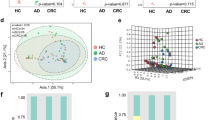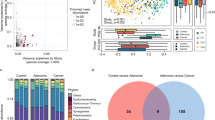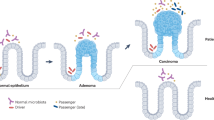Abstract
Differences in the composition of the gut microbial community have been associated with diseases such as obesity, Crohn’s disease, ulcerative colitis and colorectal cancer (CRC). We used 454 titanium pyrosequencing of the V1–V2 region of the 16S rRNA gene to characterize adherent bacterial communities in mucosal biopsy samples from 33 subjects with adenomas and 38 subjects without adenomas (controls). Biopsy samples from subjects with adenomas had greater numbers of bacteria from 87 taxa than controls; only 5 taxa were more abundant in control samples. The magnitude of the differences in the distal gut microbiota between patients with adenomas and controls was more pronounced than that of any other clinical parameters including obesity, diet or family history of CRC. This suggests that sequence analysis of the microbiota could be used to identify patients at risk for developing adenomas.
Similar content being viewed by others
Log in or create a free account to read this content
Gain free access to this article, as well as selected content from this journal and more on nature.com
or
Accession codes
References
Abbolito MR, Ameglio F, Guerrera AM, Citarda F, Grassi A, Sciarretta F et al. (1992). The association of Helicobacter pylori infection with low levels of urea and pH in the gastric juices. Ital J Gastroenterol 24: 389–392.
Backhed F, Ding H, Wang T, Hooper LV, Koh GY, Nagy A et al. (2004). The gut microbiota as an environmental factor that regulates fat storage. Proc Natl Acad Sci USA 101: 15718–15723.
Benjamini Y, Hochberg Y . (1995). A Practical and Powerful Approach to Multiple Testing. J Roy Stat Soc B 57: 12.
Bernardet JF, Nakagawa Y, Holmes B . (2002). Proposed minimal standards for describing new taxa of the family Flavobacteriaceae and emended description of the family. Int J Syst Evol Microbiol 52: 1049–1070.
Bingham SA . (2000). Diet and colorectal cancer prevention. Biochem Soc Trans 28: 12–16.
Burcelin R, Luche E, Serino M, Amar J . (2009). The gut microbiota ecology: a new opportunity for the treatment of metabolic diseases? Front Biosci 14: 5107–5117.
Burnett-Hartman AN, Newcomb PA, Potter JD . (2008). Infectious agents and colorectal cancer: a review of Helicobacter pylori, Streptococcus bovis, JC virus, and human papillomavirus. Cancer Epidemiol Biomarkers Prev 17: 2970–2979.
Cani PD, Delzenne NM . (2009). Interplay between obesity and associated metabolic disorders: new insights into the gut microbiota. Curr Opin Pharmacol 9: 737–743.
Castellarin M, Warren RL, Freeman JD, Dreolini L, Krzywinski M, Strauss J et al. (2012). Fusobacterium nucleatum infection is prevalent in human colorectal carcinoma. Genome Res 22: 299–306.
Chen G, Fournier RL, Varanasi S, Mahama-Relue PA . (1997). Helicobacter pylori survival in gastric mucosa by generation of a pH gradient. Biophys J 73: 1081–1088.
Chou HH, Holmes MH . (2001). DNA sequence quality trimming and vector removal. Bioinformatics 17: 1093–1104.
Costello EK, Lauber CL, Hamady M, Fierer N, Gordon JI, Knight R . (2009). Bacterial community variation in human body habitats across space and time. Science 326: 1694–1697.
Duncan SH, Louis P, Flint HJ . (2004). Lactate-utilizing bacteria, isolated from human feces, that produce butyrate as a major fermentation product. Appl Environ Microbiol 70: 5810–5817.
Eckburg PB, Bik EM, Bernstein CN, Purdom E, Dethlefsen L, Sargent M et al. (2005). Diversity of the human intestinal microbial flora. Science 308: 1635–1638.
Gibson GR, Roberfroid MB . (1995). Dietary modulation of the human colonic microbiota: introducing the concept of prebiotics. J Nutr 125: 1401–1412.
Gill SR, Pop M, Deboy RT, Eckburg PB, Turnbaugh PJ, Samuel BS et al. (2006). Metagenomic analysis of the human distal gut microbiome. Science 312: 1355–1359.
Grice EA, Kong HH, Renaud G, Young AC, Bouffard GG, Blakesley RW et al. (2008). A diversity profile of the human skin microbiota. Genome Res 18: 1043–1050.
Haas BJ, Gevers D, Earl AM, Feldgarden M, Ward DV, Giannoukos G et al. (2011). Chimeric 16S rRNA sequence formation and detection in Sanger and 454-pyrosequenced PCR amplicons. Genome Res 21: 494–504.
Hope ME, Hold GL, Kain R, El-Omar EM . (2005). Sporadic colorectal cancer--role of the commensal microbiota. FEMS Microbiol Lett 244: 1–7.
Huycke MM, Gaskins HR . (2004). Commensal bacteria, redox stress, and colorectal cancer: mechanisms and models. Exp Biol Med (Maywood) 229: 586–597.
Jemal A, Siegel R, Xu J, Ward E . (2010). Cancer statistics, 2010. CA Cancer J Clin 60: 277–300.
Keku TO, Lund PK, Galanko J, Simmons JG, Woosley JT, Sandler RS . (2005). Insulin resistance, apoptosis, and colorectal adenoma risk. Cancer Epidemiol Biomarkers Prev 14: 2076–2081.
Kostic AD, Gevers D, Pedamallu CS, Michaud M, Duke F, Earl AM et al. (2012). Genomic analysis identifies association of Fusobacterium with colorectal carcinoma. Genome Res 22: 292–298.
Kunin V, Engelbrektson A, Ochman H, Hugenholtz P . (2010). Wrinkles in the rare biosphere: pyrosequencing errors can lead to artificial inflation of diversity estimates. Environ Microbiol 12: 118–123.
Lance P . (1997). Recent developments in colorectal cancer. J R Coll Physicians Lond 31: 483–487.
Larsen N, Vogensen FK, van den Berg FW, Nielsen DS, Andreasen AS, Pedersen BK et al. (2010). Gut microbiota in human adults with type 2 diabetes differs from non-diabetic adults. PLoS One 5: e9085.
Leek JT, Scharpf RB, Bravo HC, Simcha D, Langmead B, Johnson WE et al. (2010). Tackling the widespread and critical impact of batch effects in high-throughput data. Nat Rev Genet 11: 733–739.
Ley RE, Backhed F, Turnbaugh P, Lozupone CA, Knight RD, Gordon JI . (2005). Obesity alters gut microbial ecology. Proc Natl Acad Sci USA 102: 11070–11075.
Ley RE, Turnbaugh PJ, Klein S, Gordon JI . (2006). Microbial ecology: human gut microbes associated with obesity. Nature 444: 1022–1023.
Livak KJ, Schmittgen TD . (2001). Analysis of relative gene expression data using real-time quantitative PCR and the 2(-Delta Delta C(T)) Method. Methods 25: 402–408.
Malkan AD, Strollo W, Scholand SJ, Dudrick SJ . (2009). Implanted-port-catheter-related sepsis caused by Acidovorax avenae and methicillin-sensitive Staphylococcus aureus. J Clin Microbiol 47: 3358–3361.
Marchesi JR, Dutilh BE, Hall N, Peters WH, Roelofs R, Boleij A et al. (2011). Towards the human colorectal cancer microbiome. PLoS One 6: e20447.
Margulies M, Egholm M, Altman WE, Attiya S, Bader JS, Bemben LA et al. (2005). Genome sequencing in microfabricated high-density picolitre reactors. Nature 437: 376–380.
Moore WE, Moore LH . (1995). Intestinal floras of populations that have a high risk of colon cancer. Appl Environ Microbiol 61: 3202–3207.
Petrosino JF, Highlander S, Luna RA, Gibbs RA, Versalovic J . (2009). Metagenomic pyrosequencing and microbial identification. Clin Chem 55: 856–866.
Powrie F, Uhlig H . (2004). Animal models of intestinal inflammation: clues to the pathogenesis of inflammatory bowel disease. Novartis Found Symp 263: 164–174 discussion 174-168, 211-168.
Rakoff-Nahoum S, Medzhitov R . (2006). Role of the innate immune system and host-commensal mutualism. Curr Top Microbiol Immunol 308: 1–18.
Rakoff-Nahoum S, Paglino J, Eslami-Varzaneh F, Edberg S, Medzhitov R . (2004). Recognition of commensal microflora by toll-like receptors is required for intestinal homeostasis. Cell 118: 229–241.
Savage DC . (1977). Microbial ecology of the gastrointestinal tract. Annu Rev Microbiol 31: 107–133.
Scanlan PD, Shanahan F, Clune Y, Collins JK, O'Sullivan GC, O'Riordan M et al. (2008). Culture-independent analysis of the gut microbiota in colorectal cancer and polyposis. Environ Microbiol 10: 789–798.
Shen XJ, Rawls JF, Randall T, Burcal L, Mpande CN, Jenkins N et al. (2010). Molecular characterization of mucosal adherent bacteria and associations with colorectal adenomas. Gut Microbes 1: 138–147.
Sobhani I, Tap J, Roudot-Thoraval F, Roperch JP, Letulle S, Langella P et al. (2011). Microbial dysbiosis in colorectal cancer (CRC) patients. PLoS One 6: e16393.
Takakura Y, Che FS, Ishida Y, Tsutsumi F, Kurotani K, Usami S et al. (2008). Expression of a bacterial flagellin gene triggers plant immune responses and confers disease resistance in transgenic rice plants. Mol Plant Pathol 9: 525–529.
Tanaka N, Che FS, Watanabe N, Fujiwara S, Takayama S, Isogai A . (2003). Flagellin from an incompatible strain of Acidovorax avenae mediates H2O2 generation accompanying hypersensitive cell death and expression of PAL, Cht-1, and PBZ1, but not of Lox in rice. Mol Plant Microbe Interact 16: 422–428.
Tsukumo DM, Carvalho BM, Carvalho-Filho MA, Saad MJ . (2009). Translational research into gut microbiota: new horizons in obesity treatment. Arq Bras Endocrinol Metabol 53: 139–144.
Turnbaugh PJ, Gordon JI . (2009). The core gut microbiome, energy balance and obesity. J Physiol 587: 4153–4158.
Turnbaugh PJ, Hamady M, Yatsunenko T, Cantarel BL, Duncan A, Ley RE et al. (2009). A core gut microbiome in obese and lean twins. Nature 457: 480–484.
Turnbaugh PJ, Ley RE, Mahowald MA, Magrini V, Mardis ER, Gordon JI . (2006). An obesity-associated gut microbiome with increased capacity for energy harvest. Nature 444: 1027–1031.
Wang Q, Garrity GM, Tiedje JM, Cole JR . (2007). Naive Bayesian classifier for rapid assignment of rRNA sequences into the new bacterial taxonomy. Appl Environ Microbiol 73: 5261–5267.
Willing B, Halfvarson J, Dicksved J, Rosenquist M, Jarnerot G, Engstrand L et al. (2009). Twin studies reveal specific imbalances in the mucosa-associated microbiota of patients with ileal Crohn's disease. Inflamm Bowel Dis 15: 653–660.
Zhang H, DiBaise JK, Zuccolo A, Kudrna D, Braidotti M, Yu Y et al. (2009). Human gut microbiota in obesity and after gastric bypass. Proc Natl Acad Sci USA 106: 2365–2370.
Zumkeller N, Brenner H, Zwahlen M, Rothenbacher D . (2006). Helicobacter pylori infection and colorectal cancer risk: a meta-analysis. Helicobacter 11: 75–80.
Acknowledgements
This research was supported, in part, by grants from the National Institutes of Health NIH P30DK034987, R01 CA44684, P50 CA106991, R01 CA136887, K01 DK 073695. The funders had no role in study design, data collection and analysis, decision to publish or preparation of the manuscript.
Nucleotide sequence accession numbers: All 454 pyrosequence data from this study have been submitted to Genbank database under the accession # SRS 166138.1-172960.2.
Author information
Authors and Affiliations
Corresponding author
Ethics declarations
Competing interests
The authors declare no conflict of interest.
Additional information
Supplementary Information accompanies the paper on The ISME Journal website
Rights and permissions
About this article
Cite this article
Sanapareddy, N., Legge, R., Jovov, B. et al. Increased rectal microbial richness is associated with the presence of colorectal adenomas in humans. ISME J 6, 1858–1868 (2012). https://doi.org/10.1038/ismej.2012.43
Received:
Revised:
Accepted:
Published:
Issue date:
DOI: https://doi.org/10.1038/ismej.2012.43
Keywords
This article is cited by
-
Causal relationship between gut microbiota and cancers: a two-sample Mendelian randomisation study
BMC Medicine (2023)
-
Exploring the characteristics of gut microbiome in patients of Southern Fujian with hypocitraturia urolithiasis and constructing clinical diagnostic models
International Urology and Nephrology (2023)
-
Epigenetics and the role of nutraceuticals in health and disease
Environmental Science and Pollution Research (2023)
-
Presence of Akkermansiaceae in gut microbiome and immunotherapy effectiveness in patients with advanced non-small cell lung cancer
AMB Express (2022)
-
Microbiome insights into pediatric familial adenomatous polyposis
Orphanet Journal of Rare Diseases (2022)



